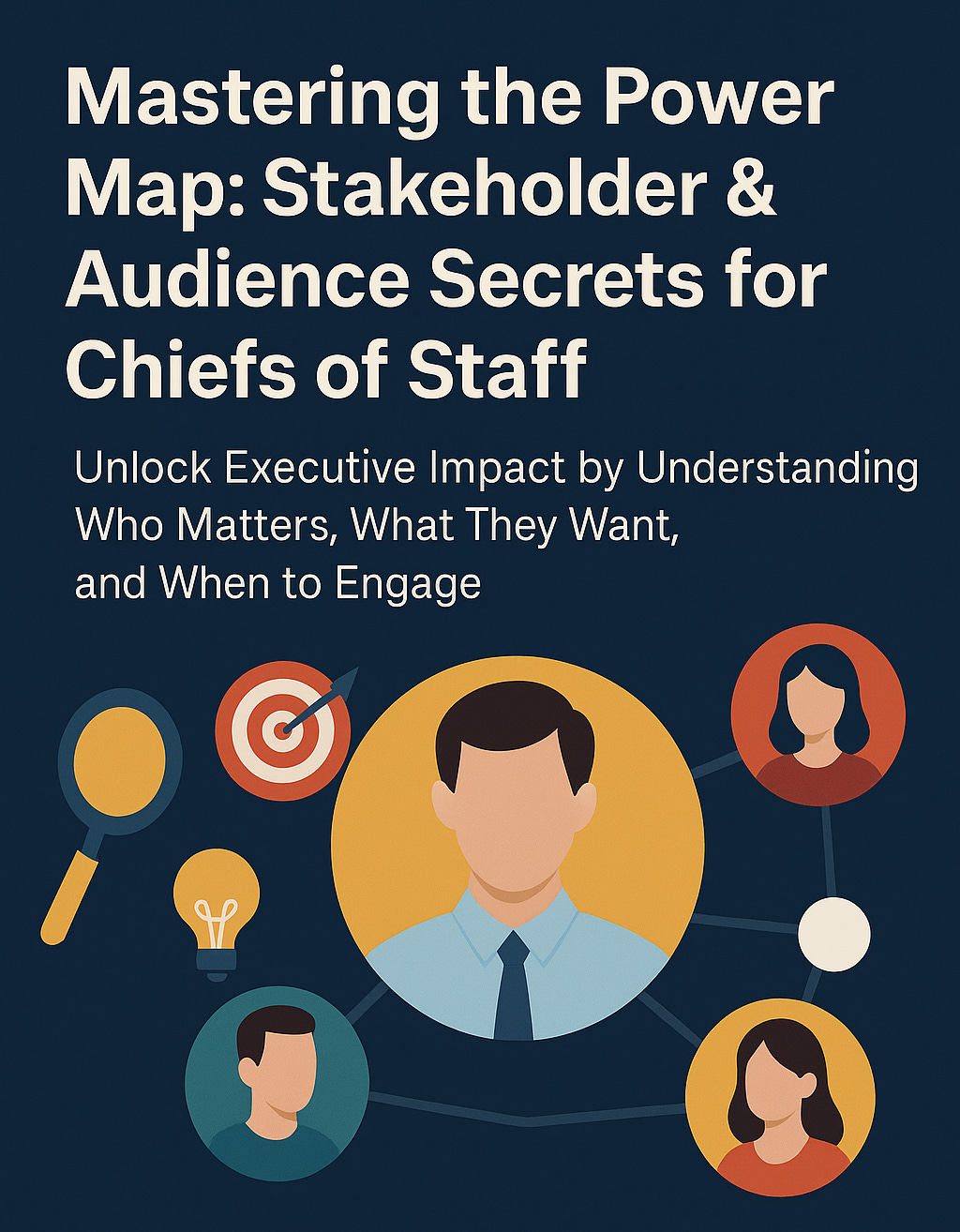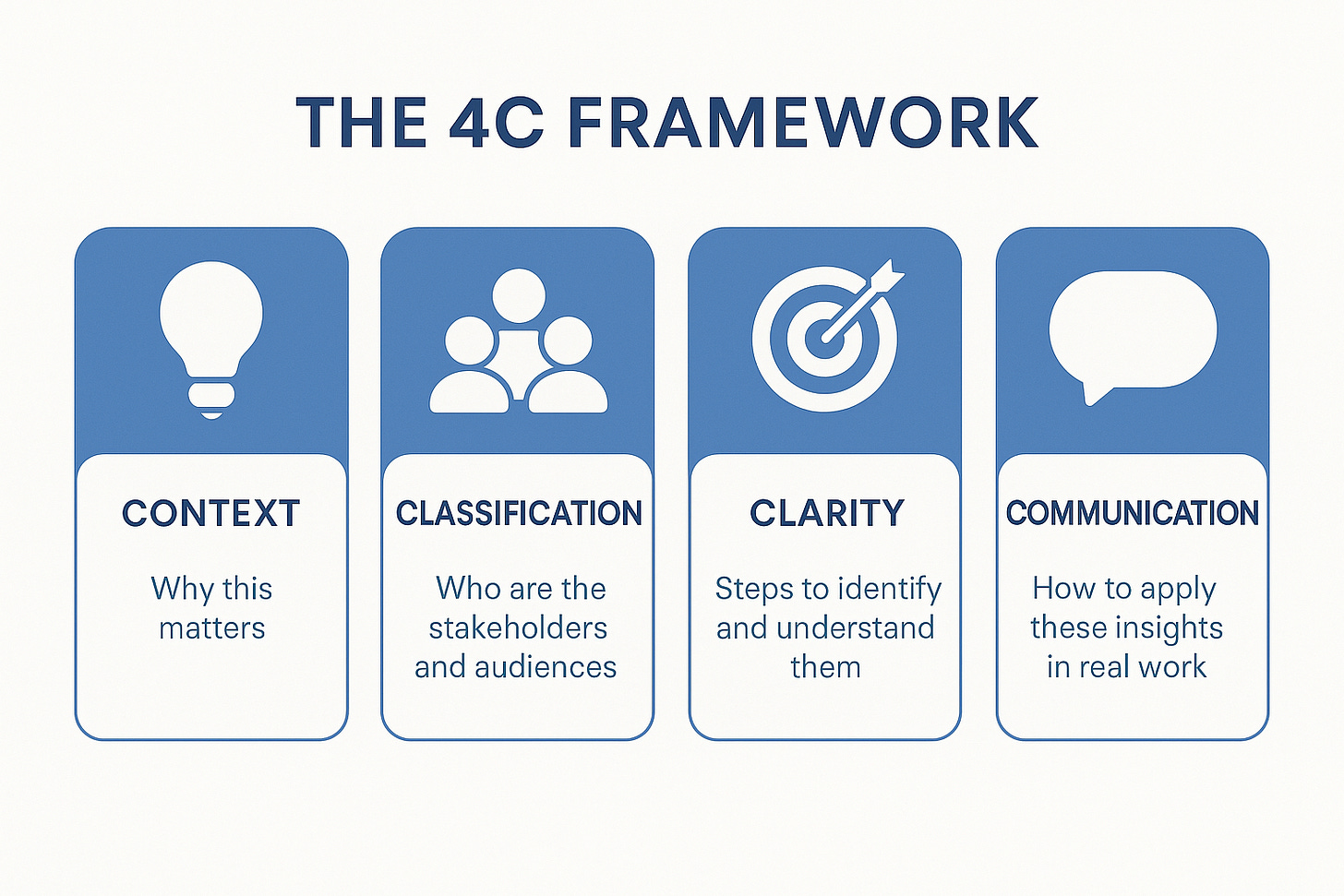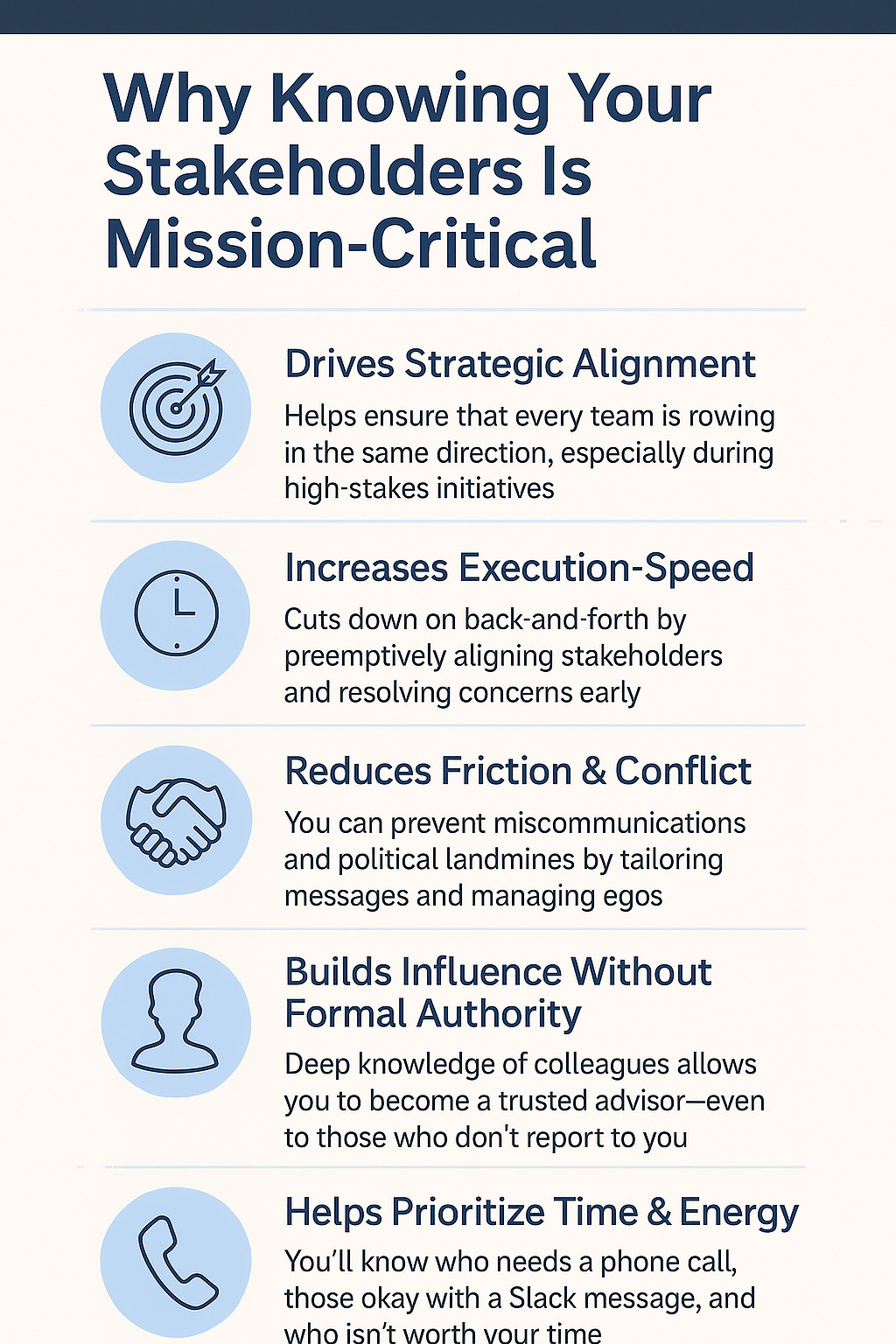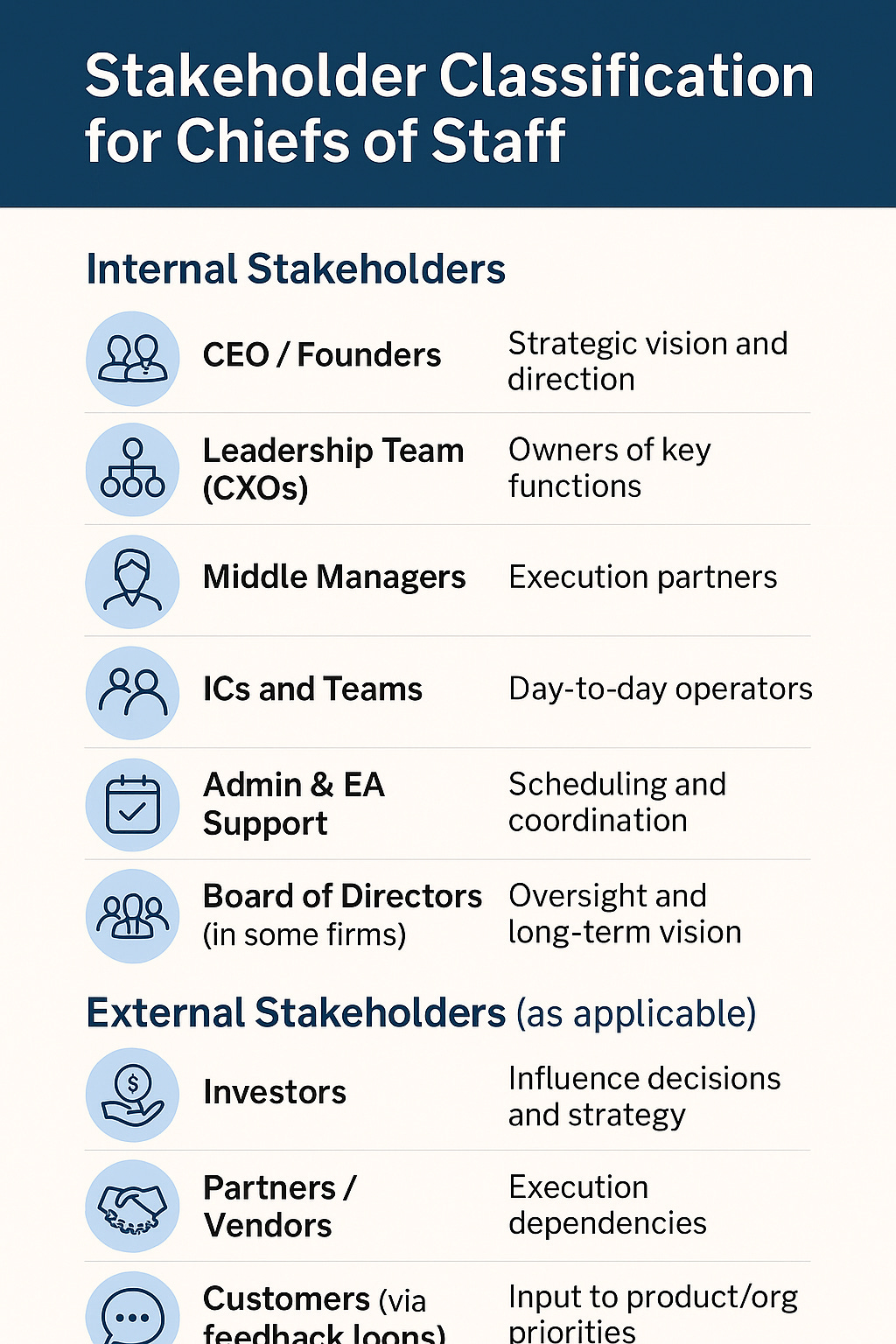Mastering the Power Map: Stakeholder & Audience Secrets for Chiefs of Staff
Unlock Executive Impact by Understanding Who Matters, What They Want, and When to Engage
Question: "As a Chief of Staff, how do you identify and understand your key stakeholders and internal audiences, and why is this critical to your effectiveness?"
To fully unlock your impact as a Chief of Staff, you must master the human side of strategy—understanding who your key stakeholders and audiences are, what drives them, and how to influence them effectively. Navigating this complexity requires more than intuition; it calls for a structured approach.
That’s why we use the 4C Framework, a practical guide to stakeholder and audience mastery:
Context – Understand why knowing your stakeholders is critical to your role and the broader organization.
Classification – Identify who they are across internal and external ecosystems.
Clarity – Learn how to uncover their priorities, communication styles, and influence.
Communication – Apply these insights to build trust, align initiatives, and drive momentum where it matters most.
This framework transforms scattered relationships into strategic levers—equipping you to operate with foresight, influence without authority, and lead from the center.
1️⃣ CONTEXT: Why This Is Critical for a Chief of Staff
As the Chief of Staff, you're not just managing meetings or projects—you're orchestrating alignment across functions, bridging communication gaps, and translating executive strategy into action. But none of this works if you don’t deeply understand the people behind the work.
Stakeholders—from the CEO to middle managers—hold unique goals, frustrations, influence levels, and communication preferences. Without knowing them well, your efforts can misfire or stall.
That’s why knowing who you're dealing with—and what makes them tick—isn't optional. It's the foundation for credibility, trust, and speed.
Why It Matters: The Chief of Staff’s Hidden Advantage
Understanding your stakeholders isn’t just about being informed—it’s your superpower for driving influence, accelerating execution, and creating seamless alignment. Here are five strategic reasons why this matters deeply:
1. Drives Strategic Alignment
When you know your stakeholders’ goals and motivations, you can align cross-functional teams around a common vision. This ensures everyone is rowing in the same direction—especially during high-stakes or fast-paced initiatives.
2. Increases Execution Speed
Time is lost in confusion and back-and-forth. By knowing how to align people quickly, anticipate objections, and resolve issues early, you reduce friction and unlock momentum.
3. Reduces Friction & Conflict
Stakeholder misalignment is the #1 silent killer of progress. Knowing their communication styles and political sensitivities helps you tailor your messaging and manage egos—before they become blockers.
4. Builds Influence Without Formal Authority
You don’t need a VP title to influence outcomes. With a deep understanding of people, you earn trust and become the go-to advisor, even for teams that don’t report to you.
5. Helps Prioritize Time & Energy
You’ll quickly learn who needs a call, who’s okay with async updates, and when not to engage at all. This saves time, reduces burnout, and ensures your energy is spent where it truly matters.
CLASSIFICATION: Who Are Your Stakeholders and Audiences?
As a Chief of Staff, you operate in a high-stakes, high-complexity environment. Your success doesn’t just depend on strategy—it hinges on people. Knowing who they are, what they care about, and how they influence the system is your edge.
To simplify the landscape, stakeholders can be grouped into two main categories:
INTERNAL STAKEHOLDERS
These are your day-to-day collaborators, advisors, and enablers. They sit within the organization and directly impact your ability to execute.
CEO / Founders
They set the vision. Your role is to help bring it to life by aligning teams, tracking priorities, and acting as a force multiplier.Leadership Team (CXOs)
These function heads (Product, HR, Marketing, Finance, etc.) are your strategic peers. You need their buy-in, updates, and alignment to keep cross-functional initiatives on track.Middle Managers
The bridge between strategy and execution. They translate big-picture decisions into team-level actions. Keeping them aligned prevents downstream chaos.ICs and Teams
The pulse of the company. Their feedback helps you spot friction early, course-correct in real time, and humanize leadership directives.Admin & EA Support
Often underestimated, they are your operational command center. They manage the flow of time, access, and information—don’t overlook their influence.Board of Directors (Optional)
While you may not engage daily, their quarterly expectations, governance lens, and long-term strategy influence your roadmap.
EXTERNAL STAKEHOLDERS
These groups may sit outside the org but have powerful influence over how you scale, partner, and make strategic bets.
Investors
They bring capital—and questions. Their confidence affects funding rounds, risk tolerance, and even leadership moves.Partners / Vendors
These collaborators often control critical dependencies—be it tech integrations, compliance timelines, or supply chain elements.Customers
Your ultimate north star. Their needs, behavior, and feedback inform what the org builds and how it evolves.
Strategic Tip: Influence ≠ Title
Some stakeholders may not be in the org chart but hold enormous sway in conversations. Always assess both:
Power (Influence) – Can they accelerate or block your initiatives?
Interest (Engagement) – How invested are they in what you’re building?
💡 As Chief of Staff, your ability to map, prioritize, and manage this ecosystem will often determine how fast and effectively your org can move.
CLARITY: How to Identify and Understand Your Stakeholders
Understanding who your stakeholders are is only half the job. The real leverage lies in knowing how to interpret their behaviors, motivations, and influence—and act accordingly.
That’s where the M.A.P. Framework comes in:
Mapping – Analysis – Prioritization
A. Mapping Stakeholders
Start with the formal org chart—but don’t stop there.
The real power often sits in the shadow org: the trusted confidants, the longtime employees who influence without title, or the culture carriers whose opinions shape teams.
🔍 Look beyond roles. Look at trust networks.
To uncover these players:
Scan OKRs to see whose metrics impact your initiatives
Analyze Slack channels, 1:1 invites, and project docs to spot recurring names
Observe who gets consulted informally—even when they’re not “owners”
B. Analyzing Interests & Influence
Once mapped, it’s time to decode how they think, act, and prefer to be engaged. Here are four dimensions to guide you:
Influence: Who can accelerate or stall initiatives? Who’s a gatekeeper, decision-maker, or blocker?
Interests: What outcomes do they care about most—OKRs, team morale, revenue, risk reduction?
Information Preferences: Do they want dashboards? Storytelling decks? One-line summaries in Slack?
Personality Style: Are they drivers (get to the point), supporters (relationship-first), analyzers (data-driven), or expressives (vision-focused)?
💡 Tip: Use frameworks like DISC or MBTI informally to help personalize your approach.
C. Prioritize Your Time and Energy
Not all stakeholders need the same level of attention.
Use the Stakeholder Power–Interest Matrix to segment them:
Engagement Strategy:
High Power, High Interest – Manage Closely: Meet regularly, involve early, and show progress.
High Power, Low Interest – Keep Satisfied: Give high-level updates and invite selectively.
Low Power, High Interest – Keep Informed: Keep in loop through async updates or newsletters.
Low Power, Low Interest – Monitor: Only engage if they become relevant later.





